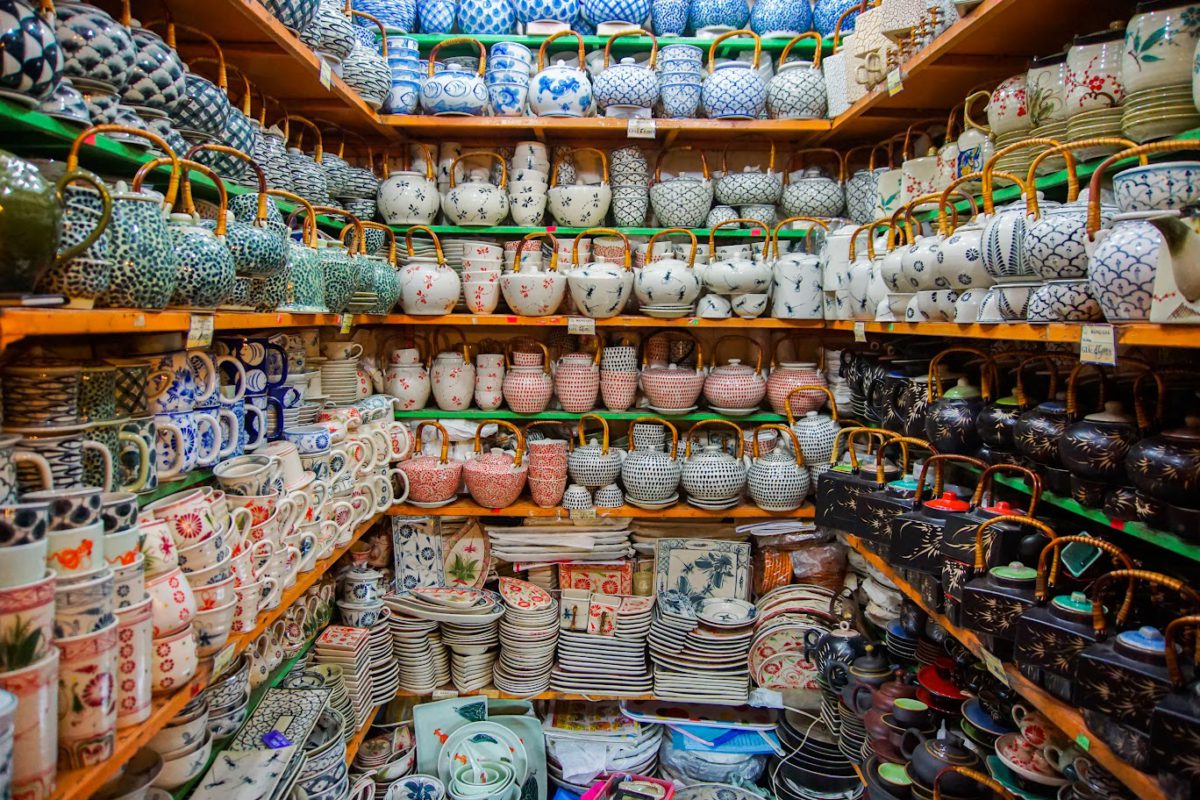Experiencing the Art of Bát Tràng Pottery Village: A National Cultural Heritage
Last Updated on 28 December, 2024 by admin
Located along the serene banks of the Red River, just 13 kilometers from the bustling center of Hanoi, lies Bát Tràng Pottery Village—a haven of traditional Vietnamese craftsmanship. Steeped in history and brimming with artistic charm, Bát Tràng is not only a center for pottery production but also a living testament to Vietnam’s cultural heritage. My visit to this enchanting village was both a journey through time and an intimate connection with the artistry of our ancestors. Let me take you through this unforgettable experience.

A Glimpse into the History and Cultural Significance of Bát Tràng
Bát Tràng’s story begins in the 14th century, born from the creative hands of artisans who migrated to this fertile land. Over centuries, it has grown into a hub of Vietnamese pottery, adapting to changing times while retaining its essence. Wandering through the village, I was struck by how every corner seemed to echo the legacy of skilled artisans who have kept this craft alive.
- A Symbol of Creativity: Each piece of pottery represents the ingenuity and hard work of the Vietnamese people. As I explored the village, I couldn’t help but admire the intricate designs and unique styles that have made Bát Tràng’s products famous worldwide.
- A Cultural Bridge: The pottery from Bát Tràng isn’t just beautiful—it’s meaningful. The motifs often depict stories of Vietnamese life, nature, and spirituality, serving as a bridge between the past and the present.
The Art of Pottery Making in Bát Tràng
One of the most fascinating aspects of my visit was observing the pottery-making process. Each piece is a testament to the dedication and precision of the artisans, and witnessing their craft up close was truly inspiring.
- Step-by-Step Creation: From selecting the finest clay to shaping, decorating, and firing the final piece, every step is a labor of love. I watched as an artisan skillfully molded a pot on a spinning wheel, his hands moving with a confidence honed by years of practice.
- Unique Characteristics: Bát Tràng pottery is renowned for its distinctive glazes, such as the crackled “men rạn” and the jade-like “men ngọc.” Seeing these finishes up close, I was amazed by their depth and luster.
Hands-On Artistry: Interactive Experiences for Visitors
One of the most memorable aspects of my visit to Bát Tràng Pottery Village was the opportunity to roll up my sleeves and immerse myself in the artistry that defines this historic destination. It wasn’t just about observing the craft—it was about becoming a part of it, experiencing firsthand the creativity and dedication that go into each piece of pottery.
Visiting Pottery Workshops
Stepping into a working pottery studio in Bát Tràng felt like entering a space where tradition seamlessly blends with creativity. The scent of wet clay and the rhythmic hum of spinning potter’s wheels set the stage for a truly magical experience.

I stood mesmerized as artisans, some of whom had been practicing their craft for decades, meticulously carved intricate patterns into soft clay. Their steady hands moved with precision and grace, whether they were applying glazes or shaping delicate handles for teapots. Watching their concentration and mastery was humbling—it was as if they were breathing life into the clay.
What struck me most was how approachable and welcoming these artisans were. One elderly potter noticed my curious gaze and invited me to sit beside him. As he explained his process in a mix of Vietnamese and gestures, I could sense his pride in continuing a craft passed down through generations. This interaction alone made the visit deeply personal and inspiring.
Making My Own Pottery
Trying my hand at shaping clay on a potter’s wheel was both thrilling and humbling. Under the patient guidance of a local artisan, I sat before the spinning wheel, a lump of wet clay in my hands. At first, my attempts were clumsy—the clay wobbled and collapsed multiple times. But the artisan, with an encouraging smile, demonstrated the technique again, and slowly, I began to understand the delicate balance between pressure and motion.
Eventually, I managed to shape a small vase, far from perfect but deeply satisfying. As I carefully etched simple designs into the clay, I felt a surge of pride. This wasn’t just an activity—it was a connection to the village’s heritage, a way of experiencing the patience and creativity that define Bát Tràng’s artistry. The finished product, even in its imperfect state, became a cherished souvenir, a tangible reminder of my hands-on experience.
Exploring the Bát Tràng Museum
The Bát Tràng Museum was another highlight, offering a fascinating glimpse into the history and evolution of this timeless craft. The museum’s architecture itself was stunning—a blend of modern design and traditional elements that mirrored the story of Bát Tràng’s pottery.
Inside, I wandered through displays of ceramics that spanned centuries, from rustic, utilitarian pots used in daily life to ornate vases and plates crafted for royalty. One section showcased the distinct glazes that Bát Tràng is famous for, such as the crackled “men rạn” and the luminous jade-like “men ngọc.” Seeing these pieces up close, I marveled at how the craft had evolved over time while retaining its essence.
The museum also included interactive exhibits where visitors could try their hand at painting ceramic tiles or assembling broken pieces of pottery—an engaging way to appreciate the intricacies of the craft. For me, the museum tied together the experience of visiting the workshops and making my own pottery, offering a deeper understanding of Bát Tràng’s enduring legacy.
A Deeply Personal Connection
What made these experiences so special was the personal connection I felt to the craft and the people of Bát Tràng. From the artisans who welcomed me into their workshops to the guides who shared stories about the village’s history, every moment felt authentic and enriching.
Creating my own piece of pottery wasn’t just about the finished product—it was about the process, the hands-on learning, and the connection to a craft that has been nurtured for generations. It gave me a newfound appreciation for the skill and effort behind every piece of Bát Tràng pottery and left me with memories that I will cherish forever.
If you visit Bát Tràng, don’t just observe—participate. Dive into the artistry, get your hands dirty, and take home more than just a souvenir. Take home a piece of Vietnam’s cultural soul.
Shopping and Souvenirs: Bringing Home a Piece of Bát Tràng
No trip to Bát Tràng would be complete without exploring its vibrant market. Shelves brimming with handcrafted ceramics offered everything from delicate tea sets to bold decorative vases. After much deliberation, I chose a hand-painted bowl adorned with lotus flowers—a symbol of Vietnam’s beauty and resilience.
Preserving and Promoting the Legacy of Bát Tràng: A Personal Perspective
Bát Tràng Pottery Village is much more than a picturesque destination—it is a vibrant, living testament to Vietnam’s rich cultural heritage. As I wandered through its narrow alleys, admiring shelves of gleaming ceramics and hearing the rhythmic hum of spinning potter’s wheels, I realised that this village represents a delicate balance between tradition and modernity. My visit gave me a deeper appreciation for the efforts being made to preserve and promote its legacy, and I felt privileged to witness this cultural preservation in action.
Conserving Tradition: Passing Down the Artistry
The foundation of Bát Tràng’s identity lies in its centuries-old pottery techniques, passed down through generations.
- Watching the Masters at Work: At one workshop, I observed an elderly artisan skillfully shaping a clay pot with practiced hands. His calm focus and precision were mesmerizing, a reminder of the years of dedication required to master this craft. What moved me most was seeing his grandson sitting beside him, mimicking his every move. It was clear that this was more than a profession—it was a family legacy being lovingly nurtured.
- A Living Heritage: Efforts to preserve traditional techniques are evident in every corner of the village. Many workshops prominently display their use of age-old methods, such as hand-moulding and using traditional wood-fired kilns. Learning about these processes during my visit deepened my respect for the artisans’ commitment to maintaining authenticity in a rapidly modernizing world.
Boosting the Local Economy: Supporting a Community
Bát Tràng’s integration of pottery with tourism has breathed new life into the village, providing steady livelihoods for many families.
- Engaging with Local Vendors: Walking through the pottery market, I was greeted warmly by shop owners eager to share the stories behind their products. Each piece on display wasn’t just a ceramic item—it was a reflection of their hard work and creativity. Buying a hand-painted tea set felt more meaningful knowing I was directly supporting their craft.
- Tourism as a Lifeline: My guide explained how the influx of visitors has not only provided financial stability but also inspired artisans to innovate while staying true to their roots. For example, some workshops now offer contemporary designs that appeal to younger audiences, blending modern aesthetics with traditional craftsmanship.
Participating in this ecosystem made me feel like a part of something bigger—helping to sustain a cultural treasure while enjoying its beauty and charm.
Inspiring Future Generations: Sparking Pride in Heritage
Perhaps the most heartening aspect of my visit was seeing how Bát Tràng fosters a sense of pride and continuity in the younger generation.
- Educational Programs: At the Bát Tràng Ceramic Museum, I joined a pottery-making session filled with children and families. Watching the little ones eagerly shape clay into vases and bowls reminded me of how important it is to engage the next generation. Many of these children, I learned, were local students participating in programs designed to teach them about their heritage.
- Visitors as Participants: As a traveller, being invited to try my hand at pottery was not just a fun activity—it was a way to connect with the craft on a personal level. My own misshapen clay bowl may not have been perfect, but the experience left me with a newfound appreciation for the skill and patience required to create even the simplest piece.
- Cultivating Pride: One artisan told me that seeing visitors from around the world admire their work motivates them to continue their craft. Knowing that their art resonates globally instills a sense of pride and responsibility to preserve it for future generations.
Bát Tràng is a shining example of how tradition and innovation can coexist, creating a sustainable model for cultural preservation. From the master artisans safeguarding ancient techniques to the children proudly shaping their first pots, every element of the village tells a story of resilience, creativity, and community.
For me, the most rewarding part of visiting Bát Tràng was realizing that I wasn’t just a spectator—I became a part of its ongoing story. Every interaction, from purchasing ceramics to attempting pottery myself, felt like a small but meaningful contribution to the preservation of this extraordinary heritage.
If you have the chance to visit, I encourage you to take the time to connect with the artisans, learn about their craft, and appreciate the deep cultural significance behind every piece. Bát Tràng isn’t just a destination—it’s a legacy, one that deserves to be celebrated, supported, and cherished by all.
Conclusion: Why Bát Tràng Should Be on Your Bucket List
Bát Tràng Pottery Village is a treasure trove of history, artistry, and culture. My visit left me with a deep appreciation for the skill and dedication that go into creating something both beautiful and meaningful. Beyond the pottery, it’s the stories, traditions, and human connections that make this village truly special.
If you’re looking for a destination that combines art, history, and hands-on experiences, Bát Tràng is the perfect place. Whether you’re crafting your own piece of pottery, admiring the work of master artisans, or simply soaking in the village’s timeless charm, you’ll leave with a renewed appreciation for Vietnam’s cultural heritage. And, like me, you’ll carry a piece of Bát Tràng with you—not just as a souvenir, but as a cherished memory.




